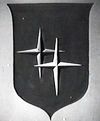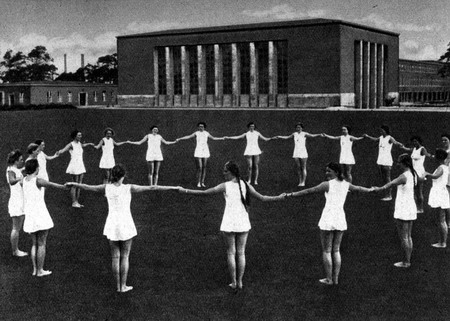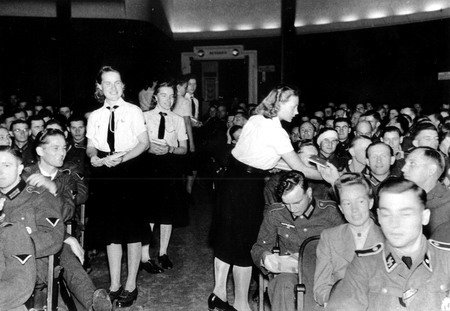A new group was founded within the League of German Girls in 1938, Das BDM-Werk Glaube und Schoenheit, the BDM Belief and Beauty Society.
The new logo of the Belief and Beauty Society, one white and one gold star on a blue background, is pictured at the right. there’s some reference to this being a “badge”, but I have not seen any images of such a badge being worn, or any such badges being sold on the collector’s market.
 Membership in this new group was voluntary and open only to girls between the ages of 17 and 21. The idea behind this new group was that it should serve as a tie-in between the League of German Girls, and the Frauenschaft, the women’s group of the Nazi party. (Members of the League of German Girls could not join the Nazi party until they were at least 18 years old.)
Membership in this new group was voluntary and open only to girls between the ages of 17 and 21. The idea behind this new group was that it should serve as a tie-in between the League of German Girls, and the Frauenschaft, the women’s group of the Nazi party. (Members of the League of German Girls could not join the Nazi party until they were at least 18 years old.)
While the Belief and Beauty society’s activities varied widely from clothing design to healthy living, many of the classes were designed to give girls a primer for their future tasks as wives and mothers. Those courses, in particular, were often taught by members of the Frauenschaft.
Even though membership in this new group was voluntary, sometimes whole groups of BDM girls joined together when they were old enough, because leaving the League of German Girls completely was somewhat looked down upon – as was leaving to get married. Girls and young women were more than ever encouraged to spend as much time as possible in the youth organizations before pursuing things like marriage and family, as well as careers.
According to Jutta Ruediger, who had taken over as the leader of the League of German girls in 1937, “The task of our Girls League is to raise our girls as torch bearers of the national-socialist world. We need girls who are at harmony between their bodies, souls, and spirits. And we need girls who, through healthy bodies and balanced minds, embody the beauty of divine creation. We want to raise girls who believe in Germany and our leader, and who will pass these beliefs on to their future children.”
Shortly after this speech made by Dr. Ruediger, Baldur von Schirach, who was the national head of the Hitler Youth, decided to found das Werk Glaube und Schoenheitalong with Dr. Ruediger.
Dr. Jutta Ruediger said about the Belief and Beauty Society, “After the younger girls learned to become a part of the community through sports and games, travel and hikes [in the Jungmaedel and BDM], older girls should be given the opportunity to follow their individual talents and interests, to further their educations accordingly, and to grow into their own unique personalities. Then they should make their talents available to the community again.” Jutta Ruediger’s view was combined with Baldur von Schirach’s view that gymnastic training should be emphasized, and the overall aim of Belief and Beauty became the “harmonic cultivation of body, mind, and spirit”.
Clementine zu Castell, who was a BDM leader from Franken, was asked to head the new organization, and after originally voicing her concern that she was “not suited to working on a national level,” she agreed to take the position.
Unlike the Jungmaedel and the League of German Girls where the importance lay on the formation of the girls’ individual characters, the Belief and Beauty Society focused on the feminine aspects such as women’s duties, fashion, and motherhood. The world of the society was mainly categorized into the following three aspects:
- feminine sports and gymnastics, particularly eurhythmic dancing
- home economics such as cooking, sewing, choosing functional furniture, etc.
- education, particularly in the arts and music, as well as politics
The overall goal of the Belief and Beauty Society was to further the young ladies’ involvement in the Volksgemeinschaft, the national community, and to raise them to make sound decisions that would lead to a healthy lifestyle for themselves and their future families. Ideally, it was also designed to get them included with the Frauenschaft, although many girls simply went on to either get a career, or marry and have a family. Even though membership was voluntary and overall membership numbers stayed relatively small, approximately 400,000 girls joined the society during the years it existed.
The smallest grouping within the society was the Arbeitsgemeinschaft, or “work group”, which was comprised of between 10 and 50 girls. Each group was led by an expert teacher, such as a lecturer or professional music teacher. The girls were introduced to life skills that would be needed in their future home and career lives, in a relaxed group atmosphere.
Work group membership was assigned based on the individual interests of the girls. Ideally, girls chose those courses that they either had the most interest in, or that would further their education and training in fields they could benefit from. Some of the courses offered were in sports and gymnastics; textile work such as screen printing or needlework; basket weaving; pottery; fashion design and sewing; and general home economics such as baking and cooking. If a girl liked the specific group she chose to participate in, she could remain in the same group for up to three years, or if she found that the group wasn’t right for her, she was able to elect a different group. Meetings were held for two hours, once a week in the evening, to accomodate those girls who were working or attending job training in the daytime.
In addition to the weekly meeting, everyone from the different groups met once a month for a community evening, during which the individual groups would report on their groups’ accomplishments and goals. Once a year, the Belief and Beauty Society had regional and national exhibits showing dance and gymnastics, performing plays, and generally showing their work.
During each year, girls had to participate in at least one work group for sports, which was one of the conditions Baldur von Schirach gave Jutta Ruediger for the new organizations. The sports work groups, were held between April and August, whereas the other work groups were held during winter.
Says Clementine zu Castell, “He wanted them to work on their beauty and their physical health. Nowadays, it’s commonplace for people to take good care of their bodies, but back then it was different. You had young girls who had jobs, and who’d otherwise not have had the opportunity to do any sports.”
The gymnastics program of the Belief and Beauty Society was strongly influenced by a 1937 visit Baldur von Schirach made to England where he attended exhibitions of the League for Health and Beauty, which used the gymnastics method of Hinrich Medau. Medau had a gymnastics school in Berlin-Schoenefeld, and first introduced his gymnastics utilizing wooden hoops during an exhibition at the 1936 Olympics in Germany.

Says Clementine zu Castell, “There were many different methods of gymnastics back then, but [he] was the one who worked most beautifully and most naturally with his girls. Schirach asked him to set up a gymnastics program for Belief and Beauty. We didn’t want the girls to do high performance work, but rather graceful movements. Medau said that as well – he did gymnastics set to music, with swinging wooden hoops and indian clubs – it was all very pretty. And it was very successful. We were [even] invited to foreign countries with our girls to show the Medau gymnastic.”
Another area that received a lot of attention within the Society was “personal life skills”. All things taste – from personal hygiene and questions of fashion to furnishing one’s home – were discussed. The feeling of everything “real” was to be fostered in the girls in terms of shapely and useful furniture, clothing, and jewelry. Each girl was supposed to do and wear what suited her and therefore create her own style that supported the development of her own character. It was thought, “What would be better suited to accent the personality of a woman than her clothing, her tastes she shows in those questions!”
Remembers Hannelore Canzler, a former member: “We did a lot of weaving in our leadership schools. Some of the regions also had weaving schools so that this old craft could be kept alive or reintroduced. It was all part of “Personal Life Skills”, even the furnishings in one’s home. We shouldn’t just senselessly put modern industrial furniture in our homes later on, but rather be careful to get useful ones.”
“Home economics” and “Agricultural / Peasantry Life Skills” are the work groups in which the girls were meant to receive the basis and direction for their future duties as housewives and mothers. The girls learned to spin, weave, iron, sew, cook, and bake – truly versatile training that would be of use later in life.
Former member Hannelore Canzler also remembers the “Healthy Life Choices” work group: “It included the areas healthy eating, such as vitamin-rich cooking; but also healthcare, nursing, and baby care. A lot of time was spent on healthy living in general. That’s why we said, “We don’t smoke, we don’t drink, and we use makeup sparingly” – just enough for the skin to still breathe underneath – “We swim a lot, and we place importance in good posture when standing or walking.” And I think that’s very important to the community in general. It’s important for the individual to live healthy and also teach that to their children.”
In all, the group encompassed 30,082 work groups by the early 1940s:
- 11,000 groups on home economics and personal living, such as cooking, sewing, tasteful clothing, culture in home and family, and tasteful decorating;
- 1, 726 groups on health service;
- 5,526 groups on sports, such as gymnastics, athletics, swimming, tennis, fencing, roller skating, ice skating, skiing, and water sports;
- 11,830 groups in other areas, such as: history, art, poetry, languages, orchestra, choir, drawing, wood-cutting, geography, and Luftschutz.
The Belief and Beauty Society, just like the League of German Girls in general, also placed a high importance on job training for girls, and tried to help girls find job fields that they were personally suited for. Prior to the League of German Girls and the job training it offered and placed importance on, the majority of women who held jobs were working as untrained help or secretaries. Only few who came from better homes and could afford the schooling and university held degrees or jobs in male-dominated field such as medicine.
During the war, younger girls often had to (or were encouraged to volunteer for) part-time jobs such as helping with the harvest, collecting for the winter relief, and helping out at stores and with deliveries. Older girls who were members of the Belief and Beauty Society were encouraged to “do their part”. The longer the war lasted, the more the work in the Belief and Beauty Society became war-related. New work groups, such as Luftschutz (air raid warden services) and Nachrichtenwesen (which encompassed operating a radio, and using morse code) were introduced.
The wartime tasks of the girls included hospital services, train station services, neighborhood help, duties with the authorities or at stores, delivering mail, air raid services, and work in preschools and kindergartens. Some of the services were:
Household Help
Child care and cleaning services for families who had many children or where the husband was away serving in the armed forces.
Store and Office Help
Civil service jobs such as letter carriers, clerks, secretaries, and factory workers. These were often jobs that needed workers to replace women who were on maternity leave, or men who were serving as soldiers.
Health Service Jobs
Helping at train stations, collecting medicinal herbs, helping with apothecary work, or working as nurse aides at hospitals
Troop Support
Visiting injured soldiers at hospitals, making care packages, or otherwise supporting the soldiers. Girls in Belief and Beauty could also take courses in fields such as stenography or morse code that were required if they chose to become Helferinnen with the armed forces.

Press photo from the webmaster’s collection: Girls of the BDM Belief and Beauty Society hand out presents to wounded soldiers at an entertainment evening.
For some very nice footage from the Belief and Beauty Society, as well as first-hand interviews with its former leaders Dr. Jutta Ruediger and Clementine zu Castell, we recommend the film “Das BDM-Werk Glaube und Schoenheit”, which is available on DVD or Video through the German publisher Zeitreisen-Verlag and in the United States through International Historic Films.
Some of the text in this article stems from first-person interviews in the mentioned documentary and was used by kind permission of Zeitreisen-Verlag in Germany.


